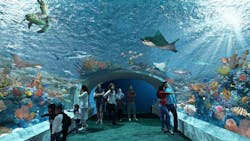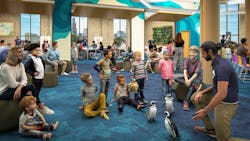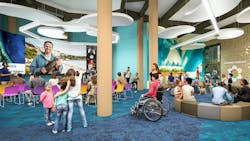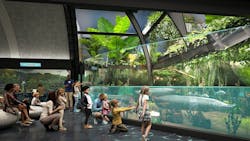The Shedd Aquarium unveils its $500 million vision for the future
The Shedd Aquarium has unveiled its strategic vision for the next 100 years. The vision, dubbed the Centennial Commitment due to the organization’s 100th anniversary in 2030, is aimed at ensuring a more equitable, sustainable, and thriving future for people and aquatic life.
The Centennial Commitment centers around three primary pillars - For People, For Communities, and For Aquatic Life. These pillars include:
- Deeper community investments and partnerships
- A modernized aquarium experience through the transformation and restoration of the historic galleries and dynamic new exhibits that provide greater and more accessible entry points
- New educational and experiential programs
- Digital engagements that bring animals and conservation action programs from the aquarium into more hands and homes
- Advancements in animal care and welfare
- Accelerated aquatic research and science
Half of the $500 million budget will power the programs and partnerships needed to achieve the Centennial Commitment’s aspirations while the other half will focus on the needed physical improvements to the historic Beaux-Arts-style building that will modernize the aquarium galleries and experience, enable greater accessibility, enhance animal habitats, and restore architectural features such as the opening of original windows that provide views of the Chicago skyline and Lake Michigan and unobstructed public access to the building’s original exterior promenade and garden spaces.
The multi-year, four phase construction project will begin in late 2022. Project highlights include:
- A modernized experience that will feature more accessible, interactive, highly immersive, and science-rich galleries
- A new learning commons located at the historic core of the aquarium on the main level that will serve as a launchpad and increase the amount of existing classroom space
- A centralized science hub that will merge five existing scientific laboratories into one central hub spanning microbial ecology, conservation science, water quality and chemistry, genome studies, and pathology
- New circulation pathways that will significantly reduce the number of transitions between areas of the aquarium, allowing guests to have multiple options regarding where they can start their journey and making navigation easier.
- Four acres of activated outdoor green space around the building that will increase natural connections to nature and bolster resilience on the lakefront while also adding experiential blue and environmental improvements.
The modernization of the historic galleries will serve as the largest capital project for the organization in recent history, preceded by the expansion of the Abbott Oceanarium in 1991 (and its reimagination in 2008), Amazon Rising exhibit in 2001, and Wild Reef exhibit in 2003.
The build team will include Pepper/BMI Construction (general contractor partners), Valerio Dewalt Train (architect), Thinc Design (exhibit design partner), JLL (project manager), Institute for Human Centered Design (accessibility partner), and Trinal (equity and inclusion partner).
Construction is slated to conclude in 2026 with new galleries, programs, and experiences opening each year on a rolling basis.





